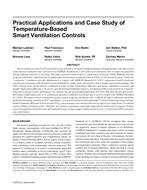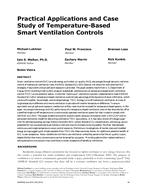Smart ventilation controls (SVCs) provide energy and indoor air quality (IAQ) advantages through dynamic real-time controlof mechanical ventilation rates. Section 4.6 of ASHRAE Standard 62.2-2013 allows for alternative SVC strategies if equivalentannual pollutant exposure is provided. This paper presents results from U.S. Department of Energy (DOE) Building Americaprogram stakeholder collaborations on temperature-based smart ventilation control (TSVC) as one potential option. Unlike the”continuous” ventilation typically implemented to comply with ASHRAE Standard 62.2-2013, temperature-based ventilationcontrols take advantage of the dynamics of stack infiltration, which varies with weather, house height, and envelope leakage. TheTSVC strategy turns off mechanical ventilation at times of large temperature difference and moves ventilation to periods withsmaller temperature differences. To ensure equivalent annual pollutant exposure, mechanical airflow rates must be increased fortemperature-based systems. In this paper, we compare the energy and IAQ performance of a TSVC that shuts the fan off at a specifiedsingle cutoff temperature to a continuously operated ventilation system fan that is sized to comply with ASHRAE Standard62.2-2013. This paper presents simulation analysis results using two simulation tools: 1) REGCAP and its advanced ventilationmodel for detraining ventilation TSVC equivalency, 2) a new beta version of EnergyGauge® USA for estimating energy savings.Relative humidity (RH) and carbon dioxide (CO2) concentrations were monitored in two occupied case study homes in cold andmarine climates involving weekly “flip flop” tests between continuous and single temperature cutoff control scenarios. Preliminaryinvestigations of market costs and modeled energy savings suggest simple paybacks of 4-11 years from TSVCs for thesecase study homes.
Citation: Thermal Performance of Exterior Envelopes of Whole Buildings XIII, Conference Papers
Product Details
- Published:
- 2016
- Number of Pages:
- 7
- Units of Measure:
- Dual
- File Size:
- 1 file , 830 KB
- Product Code(s):
- D-BldgConf16-24

